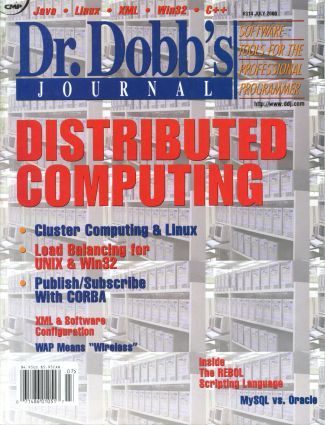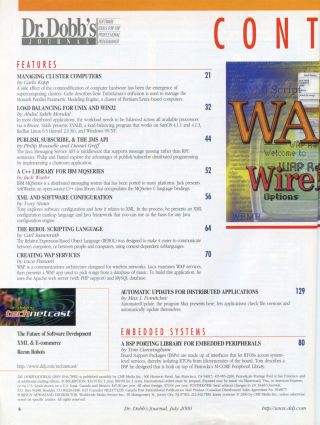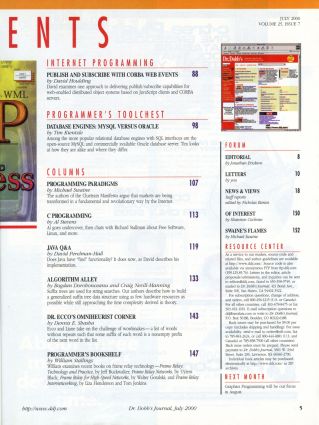
p.8 EDITORIAL
[author : Jonathan Erickson] #Edito
TABLE OF CONTENTS
FEATURES
p.21 MANAGING CLUSTER COMPUTERS
[author : Carlo Kopp]
A side effect of the commodification of computer hardware has been the emergence of supercomputing clusters. Carlo describes how TurboLinux's enFuzion is used to manage the Monash Parallel Parametric Modeling Engine, a cluster of Pentium/Linux-based computers.
p.32 LOAD BALANCING FOR UNIX AND WIN32
[author : Abdul Sakib Mondal]
In most distributed applications, the workload needs to be balanced across all available processors via software. Sakib presents XYALB, a load-balancing program that works on SunOS 4.1.1 and 4.1.3, Redhat Linux 6.5 (kernel 2.0.36), and Windows 95/NT.
p.44 PUBLISH, SUBSCRIBE, & THE JMS API
[author : Philip Rousselle and Daniel Greff]
The Java Messaging Service API is middleware that supports message passing rather than RPC semantics. Philip and Daniel explore the advantages of publish/subscribe distributed programming by implementing a chatroom application.
p.52 A C++ LIBRARY FOR IBM MQSERIES
[author : Jack Woehr]
IBM MQSeries is a distributed messaging system that has been ported to many platforms. Jack presents SoftWoehr, an open-source C++ class library that encapsulates the MQSeries C language bindings.
p.56 XML AND SOFTWARE CONFIGURATION
[author : Tony Sintes]
Tony explores software configuration and how it relates to XML. In the process, he presents an XML configuration markup language and Java framework that you can use as the basis for any Java configuration engine.
p.64 THE REBOL SCRIPTING LANGUAGE
[author : Carl Sassenrath]
The Relative Expression-Based Object Language (REBOL) was designed to make it easier to communicate between computers, or between people and computers, using context-dependent sublanguages.
p.70 CREATING WAP SERVICES
[author : Luca Passani]
WAP is a communications architecture designed for wireless networks. Luca examines WAP services, then presents a WAP app used to pick songs from a database of music. To build this application, he uses the Apache web server (with PHP support) and MySQL database.
p.129 AUTOMATIC UPDATES FOR DISTRIBUTED APPLICATIONS
[author : Max I. Fomitchev]
AutomatedUpdate, the program Max presents here, lets applications check file versions and automatically update themselves.
EMBEDDED SYSTEMS
p.80 A BSP PORTING LIBRARY FOR EMBEDDED PERIPHERALS
[author : Tom Cunningham]
Board Support Packages (BSPs) are made up of interfaces that let RTOSs access system-level services, thereby isolating RTOSs from idiosyncrasies of the board. Tom describes a BSP he designed that is built on top of Motorola's M-CORE Peripheral Library.
INTERNET PROGRAMMING
p.88 PUBLISH AND SUBSCRIBE WITH CORBA WEB EVENTS
[author : David Houlding]
David examines one approach to delivering publish/subscribe capabilities for web-enabled distributed object systems based on JavaScript clients and CORBA servers.
PROGRAMMER'S TOOLCHEST
p.98 DATABASE ENGINES: MYSQL VERSUS ORACLE
[author : Tim Kientzle]
Among the more popular relational database engines with SQL interfaces are the open-source MySQL and commercially available Oracle database server. Tim looks at how they are alike and where they differ.
COLUMNS
p.107 PROGRAMMING PARADIGMS
[author : Michael Swaine]
The authors of the Cluetrain Manifesto argue that markets are being transformed in a fundamental and revolutionary way by the Internet.
p.113 C PROGRAMMING
[author : Al Stevens]
Al goes undercover, then chats with Richard Stallman about Free Software, Linux, and more.
p.119 JAVA Q&A
[author : David Perelman-Hall]
Does Java have "find" functionality? It does now, as David describes his implementation.
p.133 ALGORITHM ALLEY
[author : Bogdan Dorohonceanu and Craig Nevill-Manning]
Suffix trees are used for string searches. Our authors describe how to build a generalized suffix tree data structure using as few hardware resources as possible while still approaching the time complexity derived in theory.
p.143 DR. ECCO'S OMNIHEURIST CORNER
[author : Dennis E. Shasha]
Ecco and Liane take on the challenge of wordsnakes — a list of words without repeats such that some suffix of each word is a nonempty prefix of the next word in the list.
p.147 PROGRAMMER'S BOOKSHELF
[author : William Stallings]
William examines recent books on frame relay technology — Frame Relay: Technology and Practice, by Jeff Buckwalter; Frame Relay Networks, by Uyless Black; Frame Relay for High-Speed Networks, by Walter Goralski; and Frame Relay Internetworking, by Liza Henderson and Tom Jenkins.
FORUM
p.10 LETTERS
[author : you]
p.18 NEWS & VIEWS
[author : Staff reports edited by Nicholas Baran]
p.150 OF INTEREST
[author : Shannon Cochran]
p.152 SWAINE'S FLAMES
[author : Michael Swaine]

